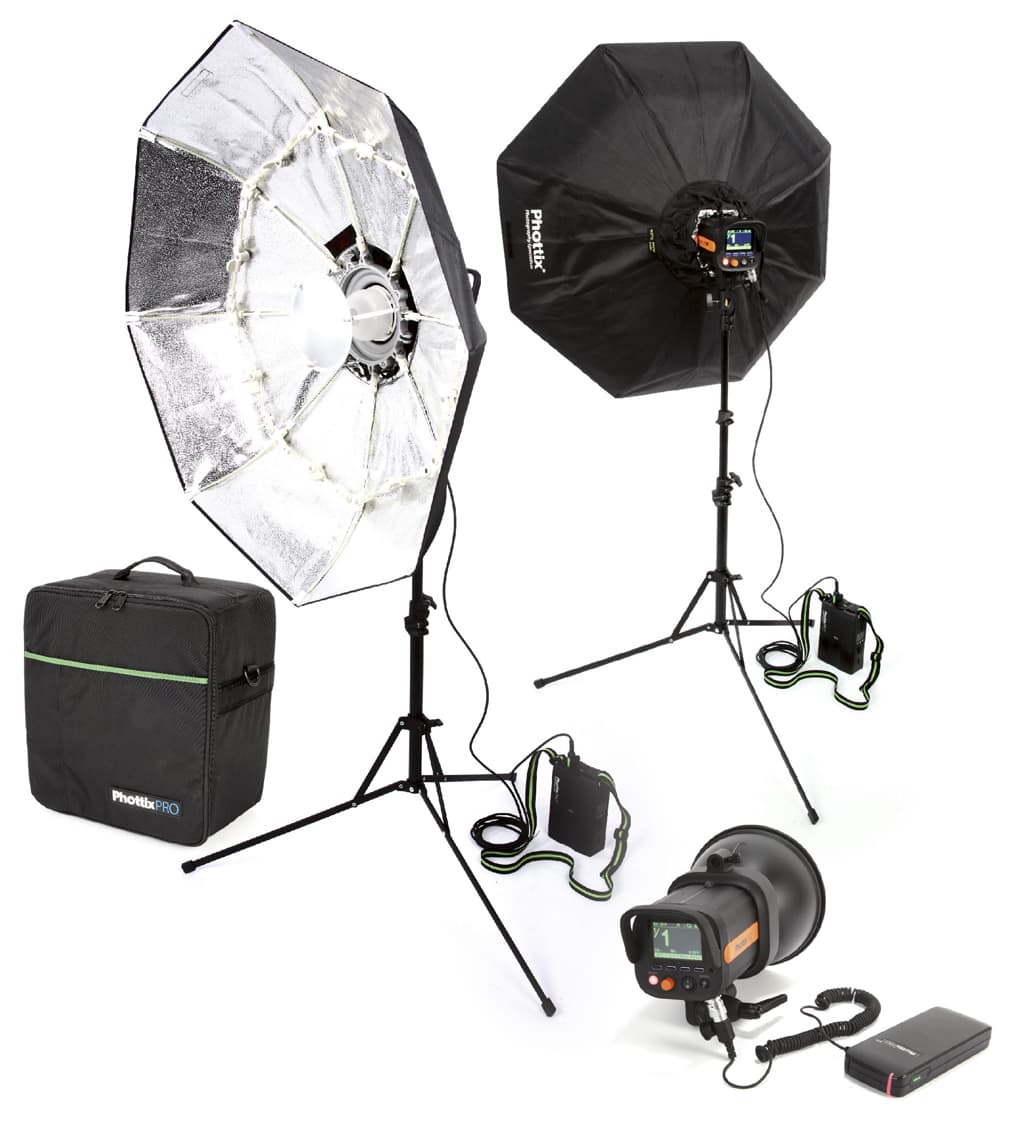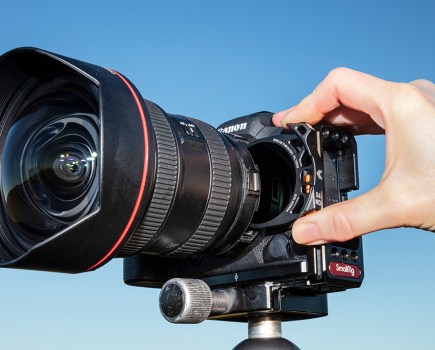 Phottix Indra lights at a glance:
Phottix Indra lights at a glance:
- Indra500, £700; with battery, £1000
- Indra360 with battery, £730
- Website: www.phottix.com
Flash specialist Phottix has come on in leaps and bounds in recent years, from its humble beginnings producing inexpensive flash triggering systems to recently launching some of the most exciting pieces of flash equipment on the market. These include the class-leading Phottix Odin system, which offers a reliable and inexpensive off-camera flash-triggering system with built-in TTL, and the Mitros+ flash unit that boasts an Odin Transceiver built into a flashgun. Phottix has now introduced another exciting bit of kit – the Phottix Indra.
The Indra is the company’s first entry into studio flash equipment and has a very impressive feature set, including TTL, high-speed sync, portable battery packs and full wireless control.
By definition, the Phottix Indra is a studio flash head, although it’s not primarily designed to be used in the studio. It’s designed to enable photographers to take studio-quality lighting on location.
Three things help the Indra achieve this goal. First, there’s a range of battery-pack options that are both light and portable (more about that later). Second, there’s a Bowens S-fit mount on the front of the unit allowing photographers to use a wide range of exceptional quality light modifiers to cover every situation. Third, there are two units with different power output (360Ws or 500Ws), but otherwise identical features to suit the majority of outdoor shooting. As a comparison, a Canon 580EX II or Nikon SB-900 hotshoe flashgun amounts to approximately 60Ws, making the Indras six to eight times more powerful.
As the Indra360Ws head requires less power to fire at its maximum capacity than the 500Ws, it can be powered with a smaller battery pack (the Indra360 battery pack). When using full-power flashes, this pack offers a 5sec recycling time and is rated to 350 flashes per charge. It measures 187x72x28.5mm and weighs just over 500g, so it’s small enough to slip into your pocket and be almost unnoticeable when attached to a flash stand.
There’s also a larger Indra battery pack, which comes in a capacity of 5,000mAh. It offers a 5sec recycle time with the Indra500Ws head and is claimed to allow 360 full-power flashes per charge. Two heads can be powered from a single pack, which also includes a 5V/2A USB port that allows users to charge devices such as a phone or tablet.
The lights feature a built-in 2.4GHz radio-triggering system that can be triggered by a Phottix Strato II or Odin trigger. When using the Odin, the Indra will shoot with TTL metering with both Canon and Nikon. Just to recap, TTL metering is where the flash and camera communicate to determine the correct flash exposure automatically. For moving subjects and scenes where the light is constantly changing, TTL metering is very useful. TTL can be controlled by ±3EV in 1⁄3-stop increments on the remote. For those not wanting to use TTL, there’s also multi-mode and full-manual mode. These are both set on the head, and full-manual mode can be wirelessly adjusted when using the Odin transmitter. Power range can be adjusted from 1/1 (full power) to 1/128 power with 1⁄3-stop increments between each power fraction.
Another useful feature is high-speed sync and second-curtain sync, so the photographer is no longer limited to shutter speeds of 1/60-1/200sec, but can instead shoot anything from a multiple second exposure right through to 1/8,000sec shutter speed. This will be most useful for photographers who want to shoot outdoors and balance ambient light with flash exposure more accurately.
Currently, the Indra features three groups, A, B and C, and four channels that allow users to control each light independently by assigning it a group and a channel. However, at Photokina 2014 Phottix announced it would have 32 channels and five groups, so it’s likely that the Indra will receive a firmware update some time soon. An update will likely also see the Odin II able to support Sony cameras with TTL. However, currently, the triggers are only available for Canon and Nikon.
Other noteworthy features include the built-in slave cell that can be triggered from the pulse of another flashgun and a modelling light. This is a small LED light with controllable output at settings of 1-10. While it’s rather dim, it is a bonus to have a modelling light featured on a flash head like this.

This image was taken with a Phottix Luna 110cm Octa on the right and a bare fill-light with a reflector on the left. Photos by Callum McInerney-Riley
Phottix Indra lights – In use
I used the Phottix Indra360 unit for a couple of Halloween-themed photo shoots, lifestyle fashion shoots and studio product photography. Throughout I found the flash to be very reliable, firing consistently and giving good quality light. The Indra360 power pack makes it really easy to have an assistant hold the light in position. Even though the flash head itself is very light, once a big modifier is added it becomes noticeably heavy. The Indra360 battery pack lasted for around 200 shots and still had half its power left – which is quite impressive. When taking multiple shots in succession, the flash’s recycle time isn’t outstanding, but it was suitable for most projects. Using the bigger battery pack with the Indra360 I was able to shoot a series of three or four full-power flashes over a few seconds.
Shooting scenes where a small amount of the subject is lit while the rest of the scene is rather dark can be quite tricky with TTL metering. It tends to vastly overestimate the flash power required and blow the highlights. I found myself dialling down the flash exposure by between -1 and -2.5EV in these situations.
However, when shooting in this manner the Indra’s TTL worked brilliantly – allowing me to move the lighting and change set-ups in each shot without needing to take multiple test exposures.
Phottix Indra lights – Our verdict
Although the Phottix Indra 360Ws worked well for overpowering the autumn sun, if I were shooting outdoor portraits consistently I’d opt for the 500Ws version to ensure never being under-powered. Overall, the Indra offers all the flexibility of flashguns, a wealth of modifiers and more powerful, better quality light. It may be a bit bigger than a flashguns set-up, but it’s a worthy trade off for its great feature set. While the TTL can be a bit inaccurate, having TTL metering and HSS on a studio kit is amazing, especially at this price point. Currently the only product with similar features is the Profoto B1, and at £1,650 per head plus battery it’s considerably more expensive. Although it’s not quite as advanced as Profoto’s built-in battery pack, the Phottix battery packs – and heads – are very light, which makes them great for taking on location.
SCORE: 5 out of 5
Phottix Indra – key specifications
Power: 360/500 watt seconds (Ws)
Adjustable power stops: 8 stops (3-360 or 4-500 Ws)
Power adjustment: In 1/3-stop or full-stop increments
Flash modes: TTL, manual, multi
Colour temp: 5500K (±200 K)
High speed sync and second curtain sync: Supported
Recycling time: Indra 360W/500W with AC adapter, 0.1-1sec (quick flash: 50 full-power flashes/min); Indra360 + Indra360 battery pack, 0.1-5sec (quick flash: 10 full-power flashes/min); Indra500 + Indra360 battery pack, 0.1-2sec (quick flash: 25 full-power flashes/min)
Input power: Phottix Indra360 + Indra360 battery pack: 350 full-power flashes; Phottix Indra500 + Indra360 battery pack: 360 full-power flashes
Receiver mode: Odin-C, Odin-N, Strato II, Opt-Slave, RX OFF (only fired via 3.5 sync port)









